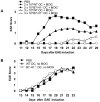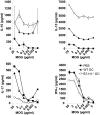B7-H1-deficiency enhances the potential of tolerogenic dendritic cells by activating CD1d-restricted type II NKT cells
- PMID: 20520738
- PMCID: PMC2875405
- DOI: 10.1371/journal.pone.0010800
B7-H1-deficiency enhances the potential of tolerogenic dendritic cells by activating CD1d-restricted type II NKT cells
Abstract
Background: Dendritic cells (DC) can act tolerogenic at a semi-mature stage by induction of protective CD4(+) T cell and NKT cell responses.
Methodology/principal findings: Here we studied the role of the co-inhibitory molecule B7-H1 (PD-L1, CD274) on semi-mature DC that were generated from bone marrow (BM) cells of B7-H1(-/-) mice and applied to the model of Experimental Autoimmune Encephalomyelitis (EAE). Injections of B7-H1-deficient DC showed increased EAE protection as compared to wild type (WT)-DC. Injections of B7-H1(-/-) TNF-DC induced higher release of peptide-specific IL-10 and IL-13 after restimulation in vitro together with elevated serum cytokines IL-4 and IL-13 produced by NKT cells, and reduced IL-17 and IFN-gamma production in the CNS. Experiments in CD1d(-/-) and Jalpha281(-/-) mice as well as with type I and II NKT cell lines indicated that only type II NKT cells but not type I NKT cells (invariant NKT cells) could be stimulated by an endogenous CD1d-ligand on DC and were responsible for the increased serum cytokine production in the absence of B7-H1.
Conclusions/significance: Together, our data indicate that BM-DC express an endogenous CD1d ligand and B7-H1 to ihibit type II but not type I NKT cells. In the absence of B7-H1 on these DC their tolerogenic potential to stimulate tolerogenic CD4(+) and NKT cell responses is enhanced.
Conflict of interest statement
Figures






References
-
- Lutz MB, Schuler G. Immature, semi-mature and fully mature dendritic cells: which signals induce tolerance or immunity? Trends Immunol. 2002;23:445–449. - PubMed
-
- Wiethe C, Schiemann M, Busch D, Haeberle L, Kopf M, et al. Interdependency of MHC class II/self-peptide and CD1d/self-glycolipid presentation by TNF-matured dendritic cells for protection from autoimmunity. J Immunol. 2007;178:4908–4916. - PubMed
-
- Pardoll DM. Spinning molecular immunology into successful immunotherapy. Nat Rev Immunol. 2002;2:227–238. - PubMed
-
- Carreno BM, Carter LL, Collins M. Therapeutic opportunities in the B7/CD28 family of ligands and receptors. Curr Opin Pharmacol. 2005;5:424–430. - PubMed
Publication types
MeSH terms
Substances
LinkOut - more resources
Full Text Sources
Molecular Biology Databases
Research Materials

